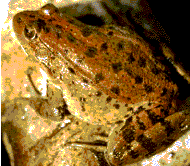 YOSEMITE VALLEY - This past year the wilderness in and around Yosemite National Park was strangely silent. Gone are the croaking songs of frogs and toads. The loss of Yosemite Toad and frog species appears to be the first documented large-scale collapse of an entire community of frog species.
YOSEMITE VALLEY - This past year the wilderness in and around Yosemite National Park was strangely silent. Gone are the croaking songs of frogs and toads. The loss of Yosemite Toad and frog species appears to be the first documented large-scale collapse of an entire community of frog species.
The National Park Service has called in biologists to study the phenomenon. Park Service biologists have found that all seven native species of frogs and toads in the Yosemite region have declined since early in the century. Three of the species havetotally disappeared from Yosemite.
Park Service biologusts have compared their findings with a 1915 study of frog and toad species in Yosemite Natinal Park. The found that 80 years ago, the wilderness in and around Yosemite National Park was rife with the trilling, croaking songs of frogs and toads. This is no longer the case, according to the new study.
By comparing a recent survey of frog and toad species with one
done in 1915, researchers were able to provide long-term data needed. For while many researchers are documenting declines of frogs and toads around the world, most focus on one or a few species with data spanning 20 years at best, leaving some to question whether the drops in numbers seen are simply harmless, short-term fluctuations.
National Park Service zoologists say the new study, published in the current issue of the Journal Conservation Biology, provides some of the best evidence that the declines are a long-term problem. "I was really very impressed by the [Yosemite]study," said Dr. Martha Crump, a behavioral ecologist at Northern Arizona University in Flagstaff, suggesting that the new paper would convince the last remaining skeptics. "It's such a large fauna declining over such a large area. That's what makes this a really important study." The Smithsonian's amphibian expert Dr. Ronald Heyer, said: "It's kind of chilling in its effect. Here we have what we consider to be a relatively protected place, and amphibian declines are occurring even there."
In the 1915 study, by Dr. Joseph Grinnell and Dr. Tracy
Storer, a team of eight scientists surveyed numerous animals,
including the frogs and toads, at sites along a 90 mile line
passing through Yosemite National Park. In addition to having
that team's published survey, Drost and Fellers were able locate the original esearchers' field manuel notations and photos, enabling them to revisit those original field sites and sample the amphibian population that might still be present.
In the current study, the research was directed to the status of Yosemite frogs and toads. Drost and Fellers listened for amphibin songs, waded into pools and used nets to gather tadpoles for identification in the
field, and counted the numbers of adult amphibians present. They also searched new sites to document more thoroughly the abundances of species in the area.
Despite their efforts, the two consistently turned up far fewer
frogs and toads than did their predecessors. Three species, the
red-legged frog, the foothill yellow-legged frog and the great
basin spadefoot, were not found at any of the original or new sites
searched.
In 1915, the Western Toad was described as "exceedingly abundant" at six sites, but researchers found only a single live adult and a small group of tadpoles at just one of the original survey sites. The mountain yellow-legged frog, described in 1915 as the most abundant amphibian at high elevations, had nearly disappeared; the researchers found only a single adult and a single tadpole in their survey of the 14 original sites. The Yosemite toad had declined or disappeared at 9 of the 13 original sites. Even the Pacific treefrog, a species that is doing well in many other parts
of its range, had declined at nearly all of its high-elevation
sites.
The only species that was doing better now was the one
non-native species, the bullfrog, which was introduced to the San
Francisco Bay area in the late 1800's from the eastern and central
part of the country.
The declines occurred not only across a wide range of species
and in a large area but over a wide variety of habitats. Woodlands,
alpine tundra and high desert are included in the study transect, a
series of scattered sites running from Snelling, Calif., in the
foothills, then east into the Sierra Nevada in Yosemite National
Park and onward to Mono Lake.
The National Biological Service zoologist, Stephen Corn, speaking from
Fort Collins said researchers in other national parks
were also finding decreases in the numbers of frogs and toads,
though none so drastic or widespread. Corn said. "I think
the National Park Service needs to be pretty concerned that things
like this are happening." He said similar surveys had been
recently finished or were ongoing in Rocky Mountain, Yellowstone,
Grand Teton, Glacier, Mount Rainier and Olympic National Parks.
Researchers have ruled out habitat destruction as a cause of the disappearance. "You can't find a place on earth that's entirely pristine," Drost said, "but by and large, this is about as pristine an area as you can find in the lower 48 United States." Drost said the field sites still look essentially as they did in the 1915 photos.
Researchers have ruled out drought as a cause of the drastically
lower numbers of frogs and toads. They said acid rain was also unlikely to
be a primary cause as acidification does not appear to have played
a role in population declines in other studies in the Sierra
Nevada.

